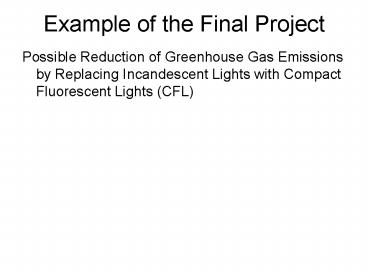Example of the Final Project PowerPoint PPT Presentation
Title: Example of the Final Project
1
Example of the Final Project
- Possible Reduction of Greenhouse Gas Emissions by
Replacing Incandescent Lights with Compact
Fluorescent Lights (CFL)
2
Outline
- Introduction
- What are CFLs and why are they more efficient
than incandescent bulbs? - How much energy can be saved per year in British
Columbia of all incandescent light bulbs are
replaced with CFLs? - What is the effect on the CO2 emissions?
3
Introduction
- Government web pages and media suggest replacing
incandescent light bulbs with compact fluorescent
light bulbs to save energy. - We want to know how much energy is saved per
household and estimate the energy savings in BC
if all the home lights were replaced by CFLs. - We also estimate the corresponding reduction in
CO2 emissions. - In our estimates, we take into account energy
used to manufacture incandescent bulbs and CFLs.
For the estimate of the BC energy savings, we
assume that ½ of all lights could be replaced by
CFLs on average.
4
What is a CFL?
- Ordinary incandescent light bulbs emit light due
to electrical heating of a thin tungsten wire.
They convert only a few to visible light (Lab
8). 90 95 of the electrical energy is
converted into heat. - A CFL is based on light emission from a gas
discharge An electric current is driven through
a gas ionizing the gas molecules. The
recombination of ions and electrons results in
light emission. - For the same light output as a 60 W light bulb a
CFL needs only 13 W of electrical power. - (Source Wikipedia)
5
How many light bulbs can we replace in BC?
- Number of households in BC 1 600 000 (in 2004)
- (http//www.env.gov.bc.ca/air/airquality/pdfs/wood
_emissions.pdf) - Estimated number of lights 20 per household.
- Estimate that due to the light quality issues,
fixtures and so on, ½ of the light bulbs will be
replaced 10 per household on average. - This includes the fact that some light bulbs were
already replaced by CFLs in the past. - Total light bulbs that could be replaced 10
bulbs per household ? 1 600 000 households 16
000 000 light bulbs
6
How much energy would be saved annually due to
replacing these bulbs?
- Assume each bulb is switched on an average of 4
hours/day - Average power 60 W. Replaced by 13 W CFL
Savings of 47 W per bulb replaced - Each home would save10 ? 47 W ? (4 h/d ? 3600
s/h ? 365 d/y) 2.5?109 J per household per
year. - For the whole province2.5?109 J ? 1 600 000
households 4?1015 J per year
7
What would be the total reduction in CO2
Emissions?
- CO2 emissions in the US are 1.34 pounds (0.608
kg) of CO2 per kWh averaged over all methods of
generating electricity - (1998 2000, Source US Government, DOE).
- Conversion between kWh and J1kWh 1000 J/s ?
3600 s/h ? 1h 3.6?106 J - Annual reduction in CO2 emissions is 4?1015 J
per year ? (1kWh / 3.6?106 J) ? 0.705 kg/kWh
8?108 kg of CO2 per year in BC
8
What would be the percentage decrease in energy
consumption?
- Total BC power production 53 000 GWhours
53?109kWh ? 3.6?106 J/kWh 2?1017 J - (http//www.bchydro.com/rx_files/info/info46749.pd
f) - The savings of 4?1015 J by switching to CFLs
would decrease our provincial energy consumptions
by 2
9
Net Energy Savings
- BC generates most of its power from hydro power
and only 10 from fossil fuels. So is there less
benefit? - Energy market is international and so is
pollution Energy saved here will still impact
global carbon emissions. - But we need to include energy needed to produce
the CFLs and light bulbs. Hard to find numbers
Higher manufacturing cost of CFL is offset by its
much longer lifetime - Lifetime 10 000 h (CFL) vs 1000 h
(incandescent) (Source Wikipedia) - So the raw energy savings we estimated in the
previous slides are approximately equal to the
net energy savings.
10
Negative Effects
- CFLs and other fluorescent lamps have small
amount of mercury ( 20 mg Hg) . - Since mercury is toxic, CFLs should be recycled.
Ordinary fluorescent bulbs can be recycled and
almost all of the mercury can be recovered. - (Source www.worldwise.com)
- Heat?
- Quality of light?
- http//www.npr.org/templates/story/story.php?story
Id7431198
11
Conclusion
- Replacing incandescent bulbs with CFL leads to
significant savings in energy (and money). - BCs energy consumption would decrease by
approximately 2 if all households would replace. - Higher production cost of CFLs are offset by much
longer lifetime. - Concerns about mercury content in CFLs could be
addressed by mandatory recycling programs.

